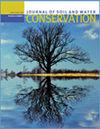去除木屑覆盖物后土壤的可蚀性:风洞试验
IF 2.6
4区 农林科学
Q2 ECOLOGY
引用次数: 0
摘要
大量的田间研究调查了覆盖对土壤风蚀的影响。然而,人们对去除地膜后土壤可蚀性的变化知之甚少。本文以某城市公园为研究对象,通过风洞试验测定了去除地膜后土壤的理化性质和团聚体特征,并估算了土壤中可风蚀性物质的排放。2019年10月至2021年2月底,在圆明园公园某区域采用覆盖厚度为4500 g m−2(覆盖厚度为5 cm, R5)、6300 g m−2(覆盖厚度为7 cm, R7)和8100 g m−2(覆盖厚度为9 cm, R9)的木屑进行覆盖。列出了4个处理:无膜土壤(CK)、R5、R7和R9。与对照相比,覆盖后R5、R7和R9的土壤含水量(SM)、大团聚体(>0.25 mm)比(M >0.25)、风蚀分数(WEF)和干团聚体稳定性(DAS)显著增加(P < 0.05),土壤有机质含量(SOM)仅略有增加。不同处理间碳酸钙(CaCO3)含量差异较大。在风洞试验的基础上,对土壤表面(0 ~ 30 cm)附近风蚀物质的分布拟合对数、幂和指数函数(R2范围为0.7179 ~ 0.9859)。所有可风蚀材料的粒径分布均呈单峰分布,其中粗颗粒(250 ~ 100 μm)所占比例最高。覆盖后,与对照相比,R5、R7和R9的平均风蚀率(AWER)分别降低了48.44%、65.04%和70.03%。AWER与SM、M > 0.25、WEF、DAS呈显著负相关(P < 0.01),与CaCO3、SOM呈显著负相关(P < 0.01)。CaCO3与M > 0.25、WEF、DAS呈显著正相关(P < 0.05)。总体而言,尽管覆盖周期相对较短(16个月),但木屑覆盖改善了土壤的理化性质和团聚体特征,降低了土壤的可蚀性。本文章由计算机程序翻译,如有差异,请以英文原文为准。
Soil erodibility after the removal of wood chip mulch: A wind tunnel experiment
Numerous field studies have investigated the effects of mulching on soil wind erosion. However, little is known about the changes in soil erodibility after removing the mulch layer. In this paper, we measured the physicochemical properties and aggregate characteristics of soil from an urban park after removing the mulch layer and estimated wind-erodible materials emission by wind tunnel experiments. Wood chips at 4,500 g m−2 (mulch thickness of 5 cm, R5), 6,300 g m−2 (mulch thickness of 7 cm, R7), and 8,100 g m−2 (mulch thickness of 9 cm, R9) were used for mulching an area in Yuanmingyuan Park from October of 2019 to the end of February of 2021. The following four treatments were listed: unmulched soil (CK), R5, R7, and R9. Compared with CK, the soil moisture content (SM), the macroaggregates (>0.25 mm) ratio (M > 0.25), the wind erodible fraction (WEF), and the dry aggregate stability (DAS) of R5, R7, and R9 were significantly increased after mulching (P < 0.05), whereas the soil organic matter content (SOM) was only slightly increased. The calcium carbonate contents (CaCO3) varied greatly among the different treatments. Based on the wind tunnel experiments, the distribution of wind erosion materials near the soil surface (0 to 30 cm) was fitted to logarithmic, power, and exponential functions (R2 ranged between 0.7179 and 0.9859). The particle size distribution of all wind-erodible materials was unimodal, and the proportion of coarse particles (250 to 100 μm) was highest. Compared with the CK, the average wind erosion rate (AWER) of R5, R7, and R9 was decreased by 48.44%, 65.04%, and 70.03%, respectively, after mulching. The AWER was significantly (P < 0.01) negatively correlated with SM, M > 0.25, WEF, and DAS, and negatively correlated with CaCO3 and SOM. The CaCO3 was significantly (P < 0.05) positively correlated with M > 0.25, WEF, and DAS. Overall, despite the relatively short mulching period (16 months), wood chip mulch improved the physicochemical properties and aggregate characteristics of soil and decreased erodibility.
求助全文
通过发布文献求助,成功后即可免费获取论文全文。
去求助
来源期刊
CiteScore
4.10
自引率
2.60%
发文量
0
审稿时长
3.3 months
期刊介绍:
The Journal of Soil and Water Conservation (JSWC) is a multidisciplinary journal of natural resource conservation research, practice, policy, and perspectives. The journal has two sections: the A Section containing various departments and features, and the Research Section containing peer-reviewed research papers.

 求助内容:
求助内容: 应助结果提醒方式:
应助结果提醒方式:


